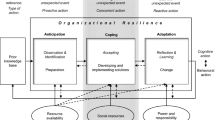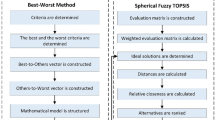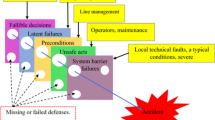Abstract
Maritime operations are complex socio-technical activities, with many interacting agents. Such agents are acting based on different, sometimes conflicting, goals. The traditional approach for safety, based on decomposition and bimodality, might lead to ineffective analyses, ignoring the transient and hidden links among activities as they are performed in everyday work. In this sense, the Functional Resonance Analysis Method (FRAM) offers a representation of work-as-done, acknowledging variability as unavoidable and desirable in order to avoid failures and maintain production. This paper adopts FRAM in combination with an Abstraction/Agency framework to understand and contribute with new perspectives to the complexity of processes. This approach, in line with the principles of Resilience Engineering, is adopted in the traditionally underspecified operation of mooring at quay. The detailed model confirms the benefits of FRAM in representing complex highly coupled tasks, especially in combination with an analysis at different levels of abstractions. The outcomes of the study show how a FRAM model offers systemic and punctual insights for understanding emergent criticalities, analysing complex incident scenarios, identifying potential mitigating actions, exploring different varieties of work and gaining systemic knowledge.










Similar content being viewed by others
References
Akhatar MJ (2014) Fatigue at sea—a manning problem. J Marit Res 11:27–42
Akyuz E, Celik M (2014) Utilisation of cognitive map in modelling human error in marine accident analysis and prevention. Saf Sci 70:19–28. doi:10.1016/j.ssci.2014.05.004
Akyuz E, Celik M (2015) Application of CREAM human reliability model to cargo loading process of LPG tankers. J Loss Prev Process Ind 34:39–48. doi:10.1016/j.jlp.2015.01.019
Akyuz E, Celik E (2016a) A modified human reliability analysis for cargo operation in single point mooring (SPM) off-shore units. Appl Ocean Res 58:11–20. doi:10.1016/j.apor.2016.03.012
Akyuz E, Celik M (2016b) A hybrid human error probability determination approach: the case of cargo loading operation in oil/chemical tanker ship. J Loss Prev Process Ind 43:424–431. doi:10.1016/j.jlp.2016.06.020
Akyuz E, Akgun I, Celik M (2016) A fuzzy failure mode and effects approach to analyse concentrated inspection campaigns on board ships. Marit Policy Manag 43:887–908. doi:10.1080/03088839.2016.1173737
Belmonte F, Schön W, Heurley L, Capel R (2011) Interdisciplinary safety analysis of complex socio-technological systems based on the functional resonance accident model: an application to railway trafficsupervision. Reliab Eng Syst Saf 96:237–249. doi:10.1016/j.ress.2010.09.006
Bennett KB (2015) Ecological interface design and system safety: one facet of Rasmussen’s legacy. Appl Ergon. doi:10.1016/j.apergo.2015.08.001
Brodje A, Lundh M, Jenvald J, Dahlman J (2013) Exploring non-technical miscommunication in vessel traffic service operation. Cogn Technol Work 15:347–357. doi:10.1007/s10111-012-0236-5
Brooker P (2011) Experts, Bayesian Belief Networks, rare events and aviation risk estimates. Saf Sci 49:1142–1155. doi:10.1016/j.ssci.2011.03.006
Celik M (2009) Designing of integrated quality and safety management system (IQSMS) for shipping operations. Saf Sci 47:569–577. doi:10.1016/j.ssci.2008.07.002
Celik M, Topcu YI (2009) Use of an ANP to prioritize managerial responsibilities of maritime stakeholders in environmental incidents: an oil spill case. Transp Res Part D Transp Environ 14:502–506. doi:10.1016/j.trd.2009.05.008
Chen ST, Wall A, Davies P, Yang Z, Wang J, Chou YH (2013) A Human and Organisational Factors (HOFs) analysis method for marine casualties using HFACS-Maritime Accidents (HFACS-MA). Saf Sci 60:105–114. doi:10.1016/j.ssci.2013.06.009
Clay-Williams R, Hounsgaard J, Hollnagel E (2015) Where the rubber meets the road: using FRAM to align work-as-imagined with work-as-done when implementing clinical guidelines. Implement Sci 10:125. doi:10.1186/s13012-015-0317-y
Dekker S (2006) Resilience engineering: chronicling the emergence of confused consensus. In: Hollnagel E, Woods DD, Leveson N (eds) Resilience engineering: concepts and precepts. Ashgate Publishing, Ltd., Farnham, pp 77–94
Dekker S, Pruchnicki S (2014) Drifting into failure: theorising the dynamics of disaster incubation. Theor Issues Ergon Sci. doi:10.1080/1463922X.2013.856495
DMA (2006) Mooring accidents on board merchant ships. DMA, Copenhaghen
DMAIB (2014a) Safety report April 2014: PACHUCA Mooring accident on 14 December 2012. DMAIB, Valby
DMAIB (2014b) Summary report—TORM REPUBLICAN occupational accident on 3 December 2013. DMAIB, Valby
Fukuda K, Sawaragi T, Horiguchi Y, Nakanishi H (2016) Applying systemic accident model to learn from near-miss incidents of train maneuvering and operation. IFAC-PapersOnLine 49:543–548. doi:10.1016/j.ifacol.2016.10.619
Fukuoka K, Furusho M (2016) Relationship between latent conditions and the characteristics of holes in marine accidents based on the Swiss cheese model. WMU J Marit Aff 15:267–292. doi:10.1007/s13437-015-0099-8
Gemelos IC, Ventikos NP (2008) Safety in greek coastal shipping: the role and risk of human factor revisited introduction: the problem. WMU J Marit Aff 7:31–49
Harrald JR, Mazzuchi TA, Spahn J, Van Dorp R, Merrick J, Shrestha S, Grabowski M (1998) Using system simulation to model the impact of human error in a maritime system. Saf Sci 30(1):235–247. doi:10.1016/S0925-7535(98)00048-4
Hetherington C, Flin R, Mearns K (2006) Safety in shipping: the human element. J Saf Res 37:401–411. doi:10.1016/j.jsr.2006.04.007
Hollnagel E (2010) The ETTO principle: efficiency-thoroughness trade-off—why things that go right sometimes go wrong. Risk Anal 30:153–154. doi:10.1111/j.1539-6924.2009.01333.x
Hollnagel E (2012) FRAM: the functional resonance analysis method: modelling complex socio-technical systems. Ashgate, Farnham
Hollnagel E (2014) Safety-I and safety-II (the past and future of safety management). Ashgate, Farnham
Hollnagel E, Pruchnicki S, Woltjer R, Etcher S (2008) Analysis of Comair flight 5191 with the functional resonance accident model. In: 8th International symposium of the Australian aviation psychology association
Hsu WK (2015) Assessing the safety factors of ship berthing operations. J Navig 68:576–588. doi:10.1017/S0373463314000861
Jia D-J, Li F-C (2016) Study on mooring safety for a ship with constant tension mooring system. J Dalian Marit Univ 42:1–8. doi:10.16411/j.cnki.issn1006-7736.2016.03.001
Jia D-J, Li F-C, Zhao T-Y, Meng K (2016) Ship docking safety in severe sea state in harbor. Dalian Haishi Daxue Xuebao/J Dalian Marit Univ 42(1):21–26. doi:10.16411/j.cnki.issn1006-7736.2016.01.005
Knapp S, Van De Velden M (2011) Global ship risk profiles: safety and the marine environment. Transp Res Part D Transp Environ 16:595–603. doi:10.1016/j.trd.2011.08.001
Lappalainen J, Kunnaala V, Tapaninen U (2014) Present pilotage practices in Finland. WMU J Marit Aff 13:77–99. doi:10.1007/s13437-013-0055-4
Li W, Ji R, Huang T (2016) Research on mooring system under typhoon state. In: Ocean. 2016—Shanghai, pp 1–4. doi:10.1109/OCEANSAP.2016.7485693
Ljung M, Lutzhoft M (2014) Functions, performances and perceptions of work on ships. WMU J Marit Aff 13:231–250. doi:10.1007/s13437-014-0057-x
Lundblad K, Speziali J (2008) FRAM as a risk assessment method for nuclear fuel transportation. In: International conference working on safety
Maritime and Coastguard Agency (2010) Code of safe working practices for merchant Seamen. In: Consolidat. ed. The Stationery Office (TSO), Norwich (UK)
Mazaheri A, Montewka J, Nisula J, Kujala P (2015) Usability of accident and incident reports for evidence-based risk modeling—a case study on ship grounding reports. Saf Sci 76:202–214. doi:10.1016/j.ssci.2015.02.019
Mikkers M, Henriqson E, Dekker S (2013) Managing multiple and conflicting goals in dynamic and complex situations: exploring the practical field of maritime pilots. J Marit Res 9:13–18
Mukherjee PK, Brownrigg M (2013) Farthing on international shipping. 4th edn. Springer, Heidelberg, London. ISBN: 978-3-642-34598-2
Naikar N, Sanderson PM (2001) Evaluating design proposals for complex systems with work domain analysis. Hum Factors 43:529–542
OCIMF (2015) The hazards of Snap-back: initial learnings from a serious incident of mooring line failure. OCIMF, London
Patriarca R, Bergström J, Di Gravio G (2017a) Defining the functional resonance analysis space: combining Abstraction Hierarchy and FRAM. Reliab Eng Syst Saf 165:34–46. doi:10.1016/j.ress.2017.03.032
Patriarca R, Di Gravio G, Costantino F (2017b) A Monte Carlo evolution of the Functional Resonance Analysis Method (FRAM) to assess performance variability in complex systems. Saf Sci 91:49–60. doi:10.1016/j.ssci.2016.07.016
Patriarca R, Di Gravio G, Costantino F, Tronci M (2017c) The Functional Resonance Analysis Method for a systemic risk based environmental auditing in a sinter plant: a semi-quantitative approach. Environ Impact Assess Rev 63:72–86. doi:10.1016/j.eiar.2016.12.002
Pickup L, Atkinson S, Hollnagel E, Bowie P, Gray S, Rawlinson S, Forrester K (2017) Blood sampling—two sides to the story. Appl Ergon. doi:10.1016/j.apergo.2016.08.027
Praetorius G (2014) Vessel Traffic Service (VTS): a maritime information service or traffic control system? Understanding everyday performance and resilience in a socio-technical system under change. Chalmers University of Technology, Gothenburg
Praetorius G, Hollnagel E (2014) Control and resilience within the maritime traffic management domain. J Cogn Eng Decis Mak. doi:10.1177/1555343414560022
Praetorius G, Lützhöft M (2012) Decision support for vessel traffic service (VTS): user needs for dynamic risk management in the VTS. Work 41:4866–4872. doi:10.3233/WOR-2012-0779-4866
Praetorius G, Hollnagel E, Dahlman J (2015) Modelling vessel traffic service to understand resilience in everyday operations. Reliab Eng Syst Saf 141:10–21. doi:10.1016/j.ress.2015.03.020
Praetorius G, Graziano A, Schröder-Hinrichs J-U, Baldauf M (2016) Fram in FSA—introducing a function-based approach to the formal safety assessment framework. Adv Intell Syst Comput. doi:10.1007/978-3-319-41682-3_34
Rasmussen J (1985) The role of hierarchical knowledge representation in decision making and system management. IEEE Trans Syst Man Cybern SMC 15:234–243. doi:10.1109/TSMC.1985.6313353
Reason J (1990) The contribution of latent human failures to the breakdown of complex systems. Philos Trans R Soc Lond B Biol Sci 327:475–484. doi:10.1098/rstb.1990.0090
Reason J (2000) Human error: models and management. BMJ Br Med J 320:768–770
Sanderson P, Burns C (2017) Rasmussen and the boundaries of empirical evaluation. Appl Ergon. doi:10.1016/j.apergo.2016.10.003
Sandhåland H, Oltedal H, Eid J (2015) Situation awareness in bridge operations—a study of collisions between attendant vessels and offshore facilities in the North Sea. Saf Sci 79:277–285. doi:10.1016/j.ssci.2015.06.021
Sawaragi T, Horiguchi Y, Hina A (2006) Safety analysis of systemic accidents triggered by performance deviation. In: 2006 SICE-ICASE international joint conference. IEEE, pp 1778–1781. doi:10.1109/SICE.2006.315635
Schröder-Hinrichs JU (2010) Human and organizational factors in the maritime world—are we keeping up to speed? WMU. J Marit Aff 9:1–3. doi:10.1007/BF03195162
Shorrock S (2016) The varieties of human work [WWW Document]. Humanist. Syst. blog. https://humanisticsystems.com/2016/12/05/the-varieties-of-human-work/. Accessed 25 Apr 2017
Soares CG, Teixeira AP (2001) Risk assessment in maritime transportation. Reliab Eng Syst Saf 74:299–309. doi:10.1016/S0951-8320(01)00104-1
Standards Board (1994) BS 6349-4:1994 Maritime structures (part 4: Code of practice for design of fendering and mooring system). Standards Board
Sujan M-A, Felici M (2012) Combining failure mode and functional resonance analyses in healthcare settings. Lecture notes in computer science (including subseries lecture notes in artificial intelligence. Lecture notes in bioinformatics) 7612 LNCS, pp 364–375. doi:10.1007/978-3-642-33678-2_31
Toffoli A, Lefèvre JM, Bitner-Gregersen E, Monbaliu J (2005) Towards the identification of warning criteria: analysis of a ship accident database. Appl Ocean Res 27:281–291. doi:10.1016/j.apor.2006.03.003
Turan O, Kurt RE, Arslan V, Silvagni S, Ducci M, Liston P, Schraagen JM, Fang I, Papadakis G (2016) Can we learn from aviation: safety enhancements in transport by achieving human orientated resilient shipping environment. Transp Res. doi:10.1016/j.trpro.2016.05.132
UK P&I Club (2009) Risk focus: mooring. UK P&I Club, London
Valdez Banda OA, Goerlandt F, Montewka J, Kujala P (2015) A risk analysis of winter navigation in Finnish sea areas. Accid Anal Prev 79:100–116. doi:10.1016/j.aap.2015.03.024
van Westrenen F (2014) Modelling arrival control in a vessel traffic management system. Cogn Technol Work 16:501–508. doi:10.1007/s10111-014-0279-x
van Westrenen F, Praetorius G (2014) Maritime traffic management: a need for central coordination? Cogn Technol Work 16:59–70. doi:10.1007/s10111-012-0244-5
Woltjer R, Haraldsson J, Pinska-Chauvin E, Josefsson B (2013) Resilience in ATM operations: incorporating robustness and resilience in safety assessment. In: Proceedings of the 5th resilience engineering association symposium. Soesterberg, pp 25–27
Woods DD (1988) Coping with complexity: the psychology of human behaviour in complex systems. In: Goodstein LP, Andersen HB, Olsen SE (eds) Task, errors and mental models. Taylor & Francis, Bristol, pp 128–148
Yip TL (2008) Port traffic risks—a study of accidents in Hong Kong waters. Transp Res Part E Logist Transp Rev 44:921–931. doi:10.1016/j.tre.2006.09.002
Zheng Z, Tian J, Zhao T (2016) Refining operation guidelines with model-checking-aided FRAM to improve manufacturing processes: a case study for aeroengine blade forging. Cogn Technol Work. doi:10.1007/s10111-016-0391-1
Acknowledgements
The authors developed a VBA code to execute the multi-layer representation conducted in this study, and they interfaced it with the FRAM Model Visualizer (FMV), a free software based on professor Hollnagel’s FRAM, written and developed by Rees Hill, which the authors acknowledge for his contribution to the development of FRAM. Furthermore, the authors thank the safety experts and accident investigators of the Danish Maritime Accident Investigation Board (DMAIB) involved in this research, who supported the gathering of operational data and played a fundamental role for the development of the case study.
Author information
Authors and Affiliations
Corresponding author
Rights and permissions
About this article
Cite this article
Patriarca, R., Bergström, J. Modelling complexity in everyday operations: functional resonance in maritime mooring at quay. Cogn Tech Work 19, 711–729 (2017). https://doi.org/10.1007/s10111-017-0426-2
Received:
Accepted:
Published:
Issue Date:
DOI: https://doi.org/10.1007/s10111-017-0426-2




